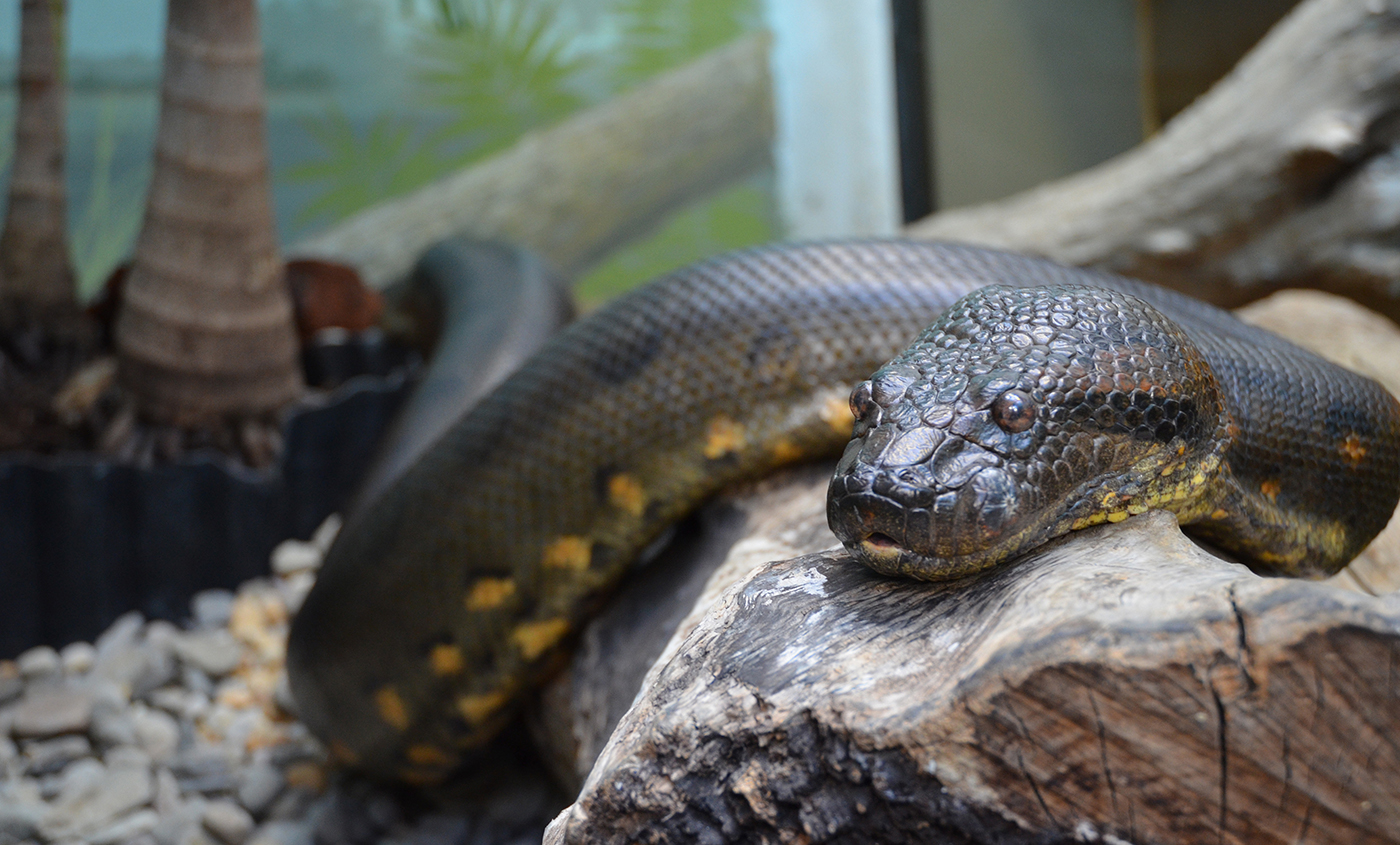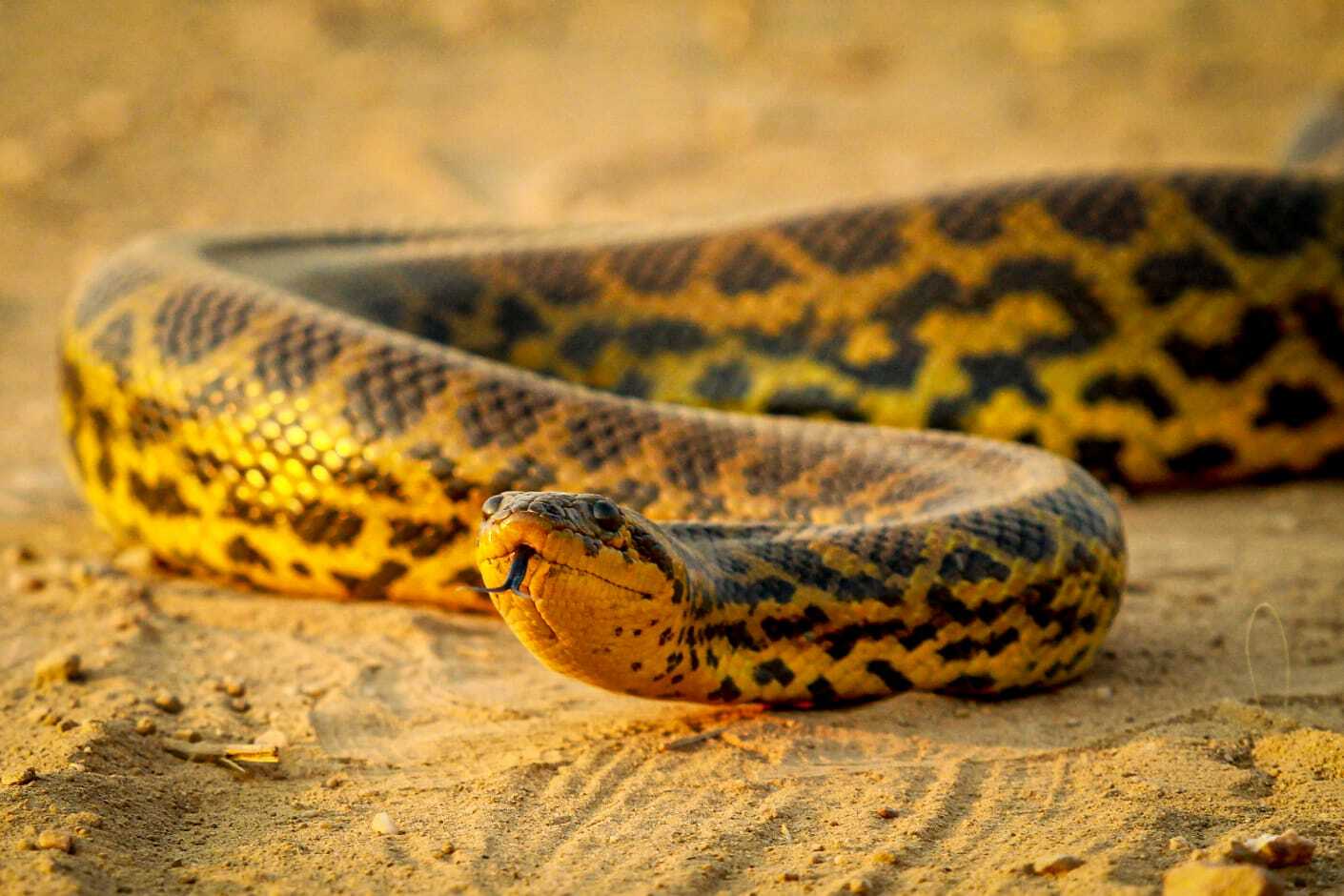Anacondas are one of the largest and most fearsome snakes in the world. They are members of the Boidae family of snakes, which includes all known boa species.
Within this family, there are 49 species of boid snakes spanning 12 different genera, and one of these genera, the Eunectes, contains all known anaconda species. There are four recognized species of anaconda, which are all non-venomous and belong to the Eunectes genus of snakes.
You are reading: 4 Types Of Anaconda Snakes
In this article, we will take an in-depth look at the four types of anaconda snakes, their traits, similarities, and differences.

4 Types Of Anaconda Snakes
Green Anaconda

The green anaconda (Eunectes murinus) is one of the largest snakes in the world, and it is a non-venomous constrictor. It is typically dark green with oval black spots along its body and smaller oval spots with yellow centers along its sides.
The scales on its belly are yellow and black. Females are considerably larger than males, and they can reach lengths of up to 30 feet (9 meters), diameters of 12 inches (30.5 centimeters), and can weigh up to 550 pounds (250 kilograms).
Green anacondas are opportunistic apex predators and eat a wide variety of prey, including fish, birds, small mammals, deer, capybara, caimans, and large birds. They are also capable of consuming a human, although this is extremely rare.
Read more : The Top 10 Fluffy Furry Fuzzy Moths In The World
Green anacondas are found in South America and the Caribbean island of Trinidad, and they prefer slow-moving rivers, flooded forest floors, and swamps. They spend most of their time in the water hunting, but they also wait in trees and drop down to surprise prey.
Green anacondas reach sexual maturity at about 3 to 4 years old, and mating generally occurs from March to May during the breeding season.
Yellow Anaconda

The yellow anaconda (Eunectes notaeus) is a non-venomous boa species that is endemic to southern South America. It is one of the largest snakes in the world, but smaller than its close relative, the green anaconda. Here are some key facts about the yellow anaconda:
– The color pattern of the yellow anaconda consists of a yellow, golden-tan, or greenish-yellow ground color overlaid with a series of black or dark brown saddles, blotches, spots, and streaks.
– Females in this species are generally larger than males.
– The range of the yellow anaconda encompasses the drainage of the Paraguay River and its tributaries, from the Pantanal region in Bolivia, Paraguay, and western Brazil to northeastern Argentina, and possibly parts of Uruguay.
– Yellow anacondas prefer mostly aquatic habitats, including swamps, marshes, and brush-covered banks of slow-moving rivers and streams.
– They are solitary snakes that can be active both during the day and night.
– When in water, yellow anacondas usually float atop the water, with their snouts barely poking out above the surface.
– Although most of their time is spent in aquatic habitats, yellow anacondas do come out onto land in order to move to other water bodies, for hunting terrestrial prey, and for mating.
– Yellow anacondas are ambush hunters and constrictors, and their digestive system is relatively slow, so they may eat only every few days.
– Their diet includes a wide variety of prey, such as fish, birds, small mammals, and reptiles.
– Little is known about the mating system in yellow anacondas.
Dark-Spotted Anaconda
The dark-spotted anaconda (Eunectes deschauenseei) is a species of snake in the subfamily Boinae of the family Boidae. Here are some interesting facts about the dark-spotted anaconda:
Physical Characteristics
– The dark-spotted anaconda has a dark brown or black base color with large, irregularly shaped yellow or cream-colored spots.
– It is smaller than the green anaconda, with a maximum length of around 13 feet (4 meters).
Habitat
– The dark-spotted anaconda is native to northeastern South America and is found primarily in low-lying swamps and marshes.
Diet
– Dark-spotted anacondas are carnivores and their prey includes fish, birds, mammals, and reptiles.
– They are constrictors and squeeze their prey to death.
Reproduction
– Little is known about the reproductive habits of the dark-spotted anaconda, but it is believed to breed once a year.
Sadly, the dark-spotted anaconda may be at the highest risk of becoming threatened in the future due to habitat loss and hunting.
Bolivian Anaconda
The Bolivian anaconda, also known as the Beni anaconda, is a non-venomous species of boa that is endemic to the northeastern parts of Bolivia.
It is the most recently defined species of anaconda and was initially believed to be a hybrid between the green and yellow anaconda species. Taxonomists and biologists finally added it to the Eunectes genus as its own distinct species in 2002.
Read more : Top 10 Stunning Red Animals
Here are some key facts about the Bolivian anaconda:
Physical Characteristics
– The Bolivian anaconda is greenish to yellowish-brown in color with round, dark brown splotches spanning the entire length of the body.
– The underside of the body is usually a lighter yellow or tan shade.
– Typically, Bolivian anacondas reach around 10 to 14 feet long and weigh around 50 to 70 pounds.
Habitat
– The Bolivian anaconda’s habitat usually consists of aquatic muddy, swampy flooded areas.
Diet
– Bolivian anacondas are carnivores and their prey includes fish, birds, mammals, and reptiles.
– They are constrictors and squeeze their prey to death.
Reproduction
– Little is known about the reproductive habits of the Bolivian anaconda.
It is important to note that the Bolivian anaconda may be at the highest risk of becoming threatened in the future due to habitat loss and hunting.
FAQS
1. How many types of anaconda snakes are there?
There are four recognized species of anacondthe green anaconda, yellow anaconda, dark-spotted anaconda, and Bolivian anaconda.
2. What is the largest species of anaconda?
The green anaconda (Eunectes murinus) is the largest species of anaconda and one of the largest snakes in the world.
3. Where are anacondas found?
Anacondas are found in tropical South America, including the Amazon basin and the Caribbean island of Trinidad.
4. What do anacondas eat?
Anacondas are carnivores and their diet includes fish, birds, small mammals, deer, capybara, caimans, and large birds.
5. Are anacondas venomous?
No, anacondas are not venomous. They are constrictors and kill their prey by squeezing it to death.
6. Are anacondas dangerous to humans?
Anacondas are not typically dangerous to humans, but they are capable of consuming a human if they feel threatened or if they mistake a person for prey. However, attacks on humans are extremely rare.
7. Are anacondas endangered?
The green anaconda is listed as a species of least concern by the International Union for Conservation of Nature (IUCN), but the yellow anaconda and dark-spotted anaconda are listed as data deficient, and the Bolivian anaconda may be at risk of becoming threatened in the future due to habitat loss and hunting.
Source: https://petstutorial.com
Category: Animals










